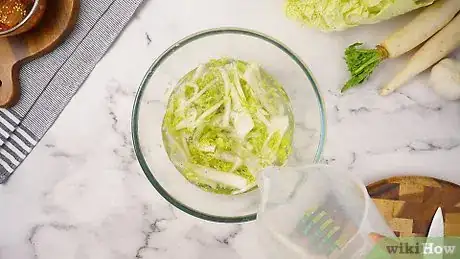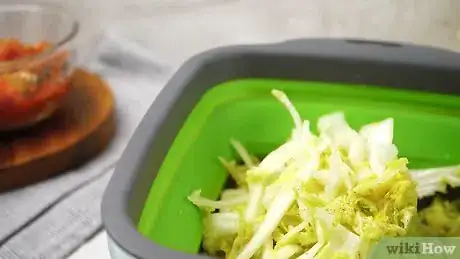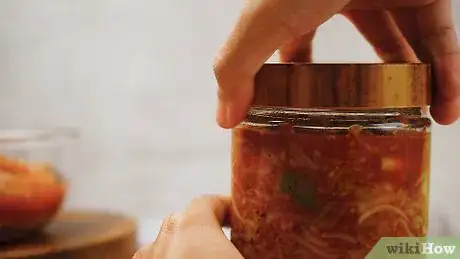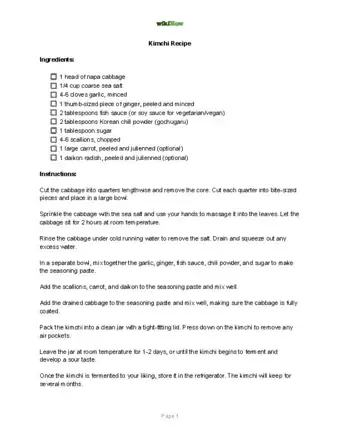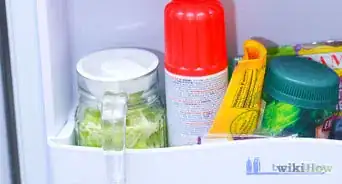This article was co-authored by Vanna Tran, a trusted member of wikiHow's volunteer community. Vanna Tran is a home cook who started cooking with her mother at a very young age. She has catered events and hosted pop-up dinners in the San Francisco Bay Area for over 5 years.
wikiHow marks an article as reader-approved once it receives enough positive feedback. In this case, several readers have written to tell us that this article was helpful to them, earning it our reader-approved status.
This article has been viewed 862,075 times.
Learn more...
Kimchi is a classic Korean dish consisting of fermented cabbage and radish. Its tasty, spicy flavor makes it an ideal additional to rice, noodles, soup, and other dishes that need a little something extra. You can purchase prepared kimchi at Korean or Asian grocery stores, but it's actually relatively easy to make at home. The key is using a glass jar for the fermentation process, and being patient enough to give the kimchi the proper time to ferment.
Ingredients
- 1 medium head napa cabbage
- ¼ cup (62 g) kosher salt
- Distilled or filtered water
- 5 to 6 garlic cloves, grated
- 1 teaspoon (2 g) grated ginger
- 1 teaspoon (4 g) sugar
- 2 to 3 tablespoons (30 to 45 ml) fish sauce
- 1 to 5 tablespoons (5 to 25 g) Korean red pepper flakes
- 8 ounces (200 g) radish, peeled and cut into matchsticks
- 4 scallions, trimmed and cut into 1-inch (2.5-cm) pieces
Steps
Salting the Cabbage
-
1Slice the cabbage into quarters. Use a sharp knife to cut 1 medium head of napa cabbage in half. Next, slice each section in half again to form quarters and remove the core section from the bottom of each quarter..[1]EXPERT TIPVanna Tran is a home cook who started cooking with her mother at a very young age. She has catered events and hosted pop-up dinners in the San Francisco Bay Area for over 5 years.Experienced Cook

 Vanna Tran
Vanna Tran
Experienced CookVanna Tran, experienced cook, says, "If you don't have napa cabbage, feel free to use any other kind of green cabbage."
-
2Cut each quarter into strips. Use the knife to slice each quarter crosswise. Create 2-inch (5-cm) wide strips from each piece so the cabbage is roughly shredded.[2]
- Traditionally, kimchi is made from cubed cabbage — you may also cut the quarters into cubes, if you prefer that size.
Advertisement -
3Combine the cabbage and salt in a bowl. Place the sliced cabbage in a large bowl and sprinkle ¼ cup (62 g) of kosher salt over it. Use clean hands to gently massage the salt into the cabbage so the leaves start to soften.[3]
- You can substitute sea salt for the kosher salt.
- You can wear kitchen gloves to protect your hands if you prefer.
EXPERT TIPVanna Tran is a home cook who started cooking with her mother at a very young age. She has catered events and hosted pop-up dinners in the San Francisco Bay Area for over 5 years.Experienced Cook
 Vanna Tran
Vanna Tran
Experienced CookWant to try something other than a salt bath? Vanna Tran, experienced cook, advises: "Growing up, my mom would dry out leaves of cabbage in the sun for a day or so to drive out the moisture instead of using a salt bath."
-
4Cover the cabbage with water and let it stand for 1 to 2 hours. Pour enough distilled or filtered water into the bowl to cover the cabbage. Place a large plate on top of the bowl, and set a heavy object like a jar or can on top to weigh it down. Let the cabbage soak in the salted water for at least an hour.[4]
- Chlorine in tap water can prevent the kimchi from fermenting, so it’s important to use distilled, filtered or bottled water.
- Avoid soaking the cabbage for more than 2 hours or it may become soggy.
-
5Pour the cabbage into a colander to drain and collect the brine. After the cabbage has soaked, dump it into a colander that’s sitting in the sink. Have a bowl beneath the colander so you can collect the salt water brine.[5]
-
6Rinse the cabbage with cold water 3 times and drain it again. Remove the bowl with brine from beneath the colander and set it aside. Run cold water from the sink faucet over the cabbage in the colander, shaking the leaves well to rinse them. Repeat the process 2 more times to ensure that the salt water is completely removed. Allow the cabbage to drain in the sink for 15 to 20 minutes so all of the water is removed.[6]
Adding the Paste
-
1Mix the garlic, ginger, sugar, and fish sauce. Add 5 to 6 grated garlic cloves, 1 teaspoon (2 g) of grated ginger, 1 teaspoon (4 g) of sugar, and 2 to 3 tablespoons (30 to 45 ml) of fish sauce to a small bowl. Stir well until a smooth paste forms.
-
2Stir in the red pepper flakes. Add 1 to 5 tablespoons (5 to 25 g) of Korean red pepper flakes to the paste. Mix well until the flakes are completely incorporated.[7]
- Korean red pepper flakes are also known as gochugaru, and can be found at Asian grocery stores and in the international aisle of some general grocery stores.
- For mild kimchi, add just a single tablespoon of the red pepper flakes. Increase the amount if you prefer a spicier flavor.
-
3Combine the cabbage, radish, scallions, and paste. Add the cabbage; 8 ounces (200 g) of peeled radish that’s been cut into matchsticks; 4 scallions that are trimmed and cut into 1-inch (2.5-cm) pieces; and the paste to a large, clean bowl. Use your hands to mix the ingredients together well until all of the vegetables are coated with the paste.[8]
- It’s a good idea to wear gloves while mixing the paste with the vegetables. The paste can sting, stain, and leave a smell behind on your skin.
Fermenting the Kimchi
-
1Pack the kimchi in a glass jar and add the brine to it. Once the vegetables and paste are combined, transfer them to a clean jar. Pour some of the brine in as well, and press down on the vegetables until the brine rises up to cover them. Seal the jar tightly with a lid.[9]
- There should be at least 1-inch (2.5-cm) of space at the top of the jar.
- If there's any brine leftover after you cover the vegetables in the jar, you can discard it.
- If you don't have a glass jar, you can ferment the kimchi in a plastic zipper bag. Be sure to squeeze out all of the excess air before sealing the bag, though.
-
2Allow the kimchi to ferment for up to 5 days. Leave the kimchi out at room temperature in the sealed jar. Let it sit for 1 to 2 days before opening the jar. Press on the kimchi with a spoon. If bubbles appear at the top, it’s properly fermented. If it hasn’t fermented, continue to let it sit, checking on it every day.[10]
- Another way to tell if the kimchi is finished fermenting is to taste it. When it has a tangy, sour flavor, it's ready.
-
3Transfer the kimchi to the refrigerator for another week or so. When the kimchi is fully fermented, place the jar in the fridge. You can eat it right away, but the flavor is usually better if you let it chill for another 1 to 2 weeks more.[11]
- Spoon some kimchi over a bowl of steamed rice for a tasty but simple meal. It also pairs well with fried rice.
- You can use kimchi to top a bowl of ramen noodles.
- For more creative dishes, consider topping a burger or sandwich with kimchi or mixing some kimchi into scrambled eggs for a bit of a kick.
-
4Store kimchi in the fridge for 3 to 5 months. As long as there's still brine in the jar, kimchi can last for several months in the refrigerator. You can usually tell that it's gone bad if brine becomes particularly fizzy with bubbles.[12]
Kimchi Shopping List and Recipe
Community Q&A
-
QuestionWhy do I have to put the plastic bag in the jar?
 Community AnswerPutting the bag in the jar will ensure that the vegetables stay submerged in the brine and don't get moldy or yeasty.
Community AnswerPutting the bag in the jar will ensure that the vegetables stay submerged in the brine and don't get moldy or yeasty. -
QuestionHow can I heat up kimchi?
 Community AnswerI suppose you could heat it in a frying pan, but you may kill the healthy bacteria inside the kimchi.
Community AnswerI suppose you could heat it in a frying pan, but you may kill the healthy bacteria inside the kimchi. -
QuestionIs there any veg substitute for fish sauce?
 Community AnswerPerhaps try a liquid amino, though Vegemite may be more suitable as it’s flavor and consistency is thicker.
Community AnswerPerhaps try a liquid amino, though Vegemite may be more suitable as it’s flavor and consistency is thicker.
Warnings
- Metals contain chemicals and heavy metals which can break down from the probiotics, so you shouldn’t use metal containers for fermenting the kimchi.⧼thumbs_response⧽
Things You’ll Need
- Sharp knife
- Large bowl
- Colander
- Small bowl
- Spoon
- Glass jar with lid
References
- ↑ https://www.streetsmartkitchen.com/how-to-make-kimchi/
- ↑ http://www.thekitchn.com/how-to-make-easy-kimchi-at-home-189390
- ↑ http://www.thekitchn.com/how-to-make-easy-kimchi-at-home-189390
- ↑ http://www.thekitchn.com/how-to-make-easy-kimchi-at-home-189390
- ↑ http://www.thekitchn.com/how-to-make-easy-kimchi-at-home-189390
- ↑ http://www.thekitchn.com/how-to-make-easy-kimchi-at-home-189390
- ↑ http://www.thekitchn.com/how-to-make-easy-kimchi-at-home-189390
- ↑ http://www.thekitchn.com/how-to-make-easy-kimchi-at-home-189390
- ↑ http://www.thekitchn.com/how-to-make-easy-kimchi-at-home-189390
About This Article
To make kimchi, first thoroughly wash your hands so you don't transfer bacteria to any of the ingredients since bacteria can disrupt the kimchi’s fermentation process. Then, cut a head of napa cabbage lengthwise into quarters. Cut each quarter into small vertical strips. Set the cabbage in a mixing bowl and add ¼ cup (60 g) of non-iodized salt. Massage the salt into the cabbage and let it sit for 2 hours. Next, rinse the cabbage under lukewarm water for a few minutes to remove the excess salt. Dry the cabbage off with paper towels. Now, peel 7 garlic cloves and place them inside a clean food processor. Add a peeled stalk of ginger roughly 3-4 inches (7.5-10 cm) in length, 1 tablespoon (4 g) of sugar, and 3 tablespoons (30 mL) of fish sauce. Blitz the ingredients on high for 30 seconds until the texture is smooth. Then, pour in 1-5 tablespoons (5-25 g) of Korean red pepper flakes based on how spicy you like your kimchi. Stir the ingredients in your processor to make sure they’ve combined. Next, chop the cabbage up into bite-sized pieces and place them in a clean mixing bowl. Peel an 8-ounce (230 g) daikon radish and dice it up into thin strips. Add the radish to your mixing bowl. Then, cut 4 green onions into 1-inch (2.5 cm) pieces and throw them in the bowl as well. Pour the pepper paste from the food processor on top of your ingredients and mix everything together with a spoon. Now, pack the mixture into a clean glass jar as densely as you can while leaving a little space at the top. Seal the jar with a lid and leave it out at room temperature in a dark part of your home for 2-5 days to ferment. The longer you let it ferment, the sourer and softer the kimchi will be. If you wait 2 days, the kimchi will be crunchy and sweet, while waiting 5 days will result in soft and sharp kimchi. Once you’re done letting it ferment, place your kimchi in the refrigerator to stop the fermentation process and store it. Your kimchi will last for 2-3 months. For specific ingredients and measurements, read on!


